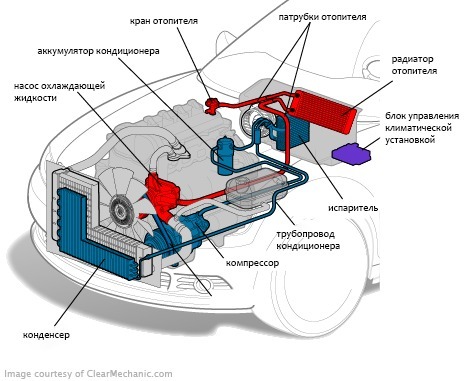
The device and principle of operation of the car stove
Content
Inexperienced car owners do not always understand why the stove in the car works and how it receives thermal energy, with the help of which it then heats the interior. Understanding the process of generating thermal energy in a car heater is important not only as a theory, but also in practice, because without such information the driver will not be able to properly use the interior heater.
Inexperienced car owners do not always understand why the stove in the car works and how it receives thermal energy, with the help of which it then heats the interior. Understanding the process of generating thermal energy in a car heater is important not only as a theory, but also in practice, because without such information the driver will not be able to properly use the interior heater.
What is a stove for?
Several names have been assigned to this unit:
- stove;
- heater;
- heater.
All of them describe its essence - the device is designed to heat the passenger compartment, so that even during fierce motors it is warm and comfortable inside the car. In addition, the heater blows hot air on the windshield, due to which snow and ice melt on it.
How the interior heating system works
The stove is part of the engine cooling system, therefore, to understand the principles of its operation, you first need to understand where the thermal energy comes from in the motor and why it is important to cool it. Modern cars, apart from electric vehicles, are equipped with motors that work by expanding gases during the combustion of an air-fuel mixture (gasoline, diesel or gas plus air), therefore such power units are called "internal combustion engines" or internal combustion engines.
Where does the excess heat come from?
After the end of the working cycle, the exhaust cycle begins, when hot gases leave the engine and enter the catalyst, where hydrocarbons and carbon monoxide are burned, so the collector often heats up to a level of 600–900 degrees. Nevertheless, during the working cycle, the burning mixture of gasoline and air manages to transfer part of the thermal energy of the BC and cylinder head, and given that the shaft rotation speed of even outdated diesel engines at idle is 550 rpm, the working cycle passes in each cylinder per second 1-2 times. As the load on the car increases, the driver presses the gas harder, which increases:
- the amount of air-fuel mixture;
- temperature during the working cycle;
- number of ticks per second.
That is, an increase in load leads to an increase in the released thermal energy and heating of all engine parts. Considering that many elements of the power plant are made of aluminum, such heating is unacceptable for them, therefore, excess heat is removed using the cooling system. The optimum temperature of the engine during operation is 95-105 degrees Celsius, it is for it that all thermal gaps of the engine are calculated, which means that the wear of parts at this temperature is minimal. Understanding the principle of obtaining excess thermal energy is necessary to answer the question - what does the stove in the car work from.

Car engine heating
Where does excess heat go?
To ensure such a regime, excess thermal energy must be dumped somewhere. In the cooling system diagram, two separate antifreeze circulation circles are designed for this, each with its own radiator (heat exchanger):
- salon (stove);
- main (engine).
The heat-radiating capacity of the saloon radiator is tens of times less than the main one, so it has a minimal effect on the temperature regime of the engine, but its performance is enough to heat the interior of the car. As the engine warms up, its temperature rises, so immediately after the driver has started the car, cold antifreeze passes through the interior heater radiator, which gradually heats up. Therefore, when the thermometer needle moves from the dead zone, warm air begins to blow from the deflectors, with the stove turned on.
The natural circulation of the coolant through the cooling system is not enough, therefore it is forcibly pumped by a water pump (pump), which is connected by a belt to the camshaft or crankshaft. Often, one belt drives the pump, generator and power steering pump (GUR). Therefore, the speed of fluid movement directly depends on the engine speed, at idle the circulation is minimal, although the parameters of the cooling system are selected so as to prevent engine overheating. But, in cars with a tired power unit and a clogged cooling system, the engine often overheats at idle.
When the engine temperature reaches 95-100 degrees, the fan turns on, which dramatically increases the cooling efficiency of the power unit, allowing it to work as efficiently as possible. Such a scheme reliably protects the motor, but does not affect the functioning of the stove in any way, because the temperature of the antifreeze passing through it is maintained at the same level, and the heat dissipation of the motor is sufficient even with maximum airflow to the saloon radiator.
How the stove heats the interior
Due to its small size and distance from the passenger compartment, the heater heat exchanger cannot directly heat the interior of the car, therefore, interior or outside air is used as a coolant. Therefore, the stove is a complex device that consists of the following elements:
- fan;
- cabin filter;
- radiator;
- cases with channels;
- dampers;
- air ducts transporting heated air to different parts of the cabin;
- deflectors that release heated air into the passenger compartment;
- controls
There are 2 types of fans installed on cars:
- centrifugal;
- propeller.
The first ones are a “snail” body, inside which an electric motor rotates a wheel equipped with blades. During rotation, the wheel spins the air, which causes centrifugal acceleration, forcing it to look for a way out of the "snail". This exit becomes a small window through which it passes at a certain speed. The faster the wheel spins, the more the fan blows.
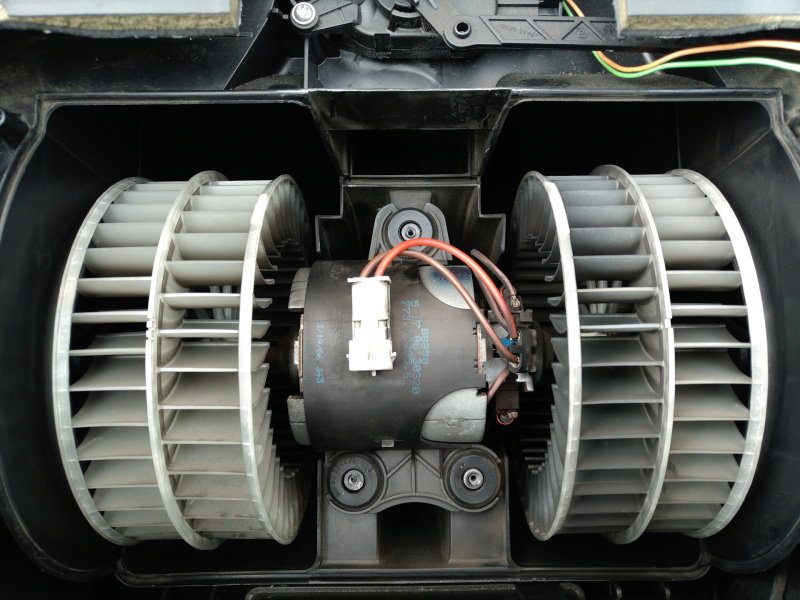
car heater fan
The second type of fan is an electric motor with a propeller (impeller) attached to its shaft. The propeller wings, bent at a certain angle, squeeze out air during movement. Such fans are cheaper to manufacture, and also take up less space, but are less efficient, so they were installed only on outdated models of budget cars, for example, the entire classic family of VAZ cars, that is, the legendary Zhiguli.
Cabin Filter
The stove sucks air from the lower part of the engine compartment, so there is a high probability of small stones and other debris entering the air intake, which can damage the fan or radiator. The filter element is made in the form of a removable cartridge, and the air is cleaned by a non-woven synthetic material folded into an accordion with antibacterial impregnation.
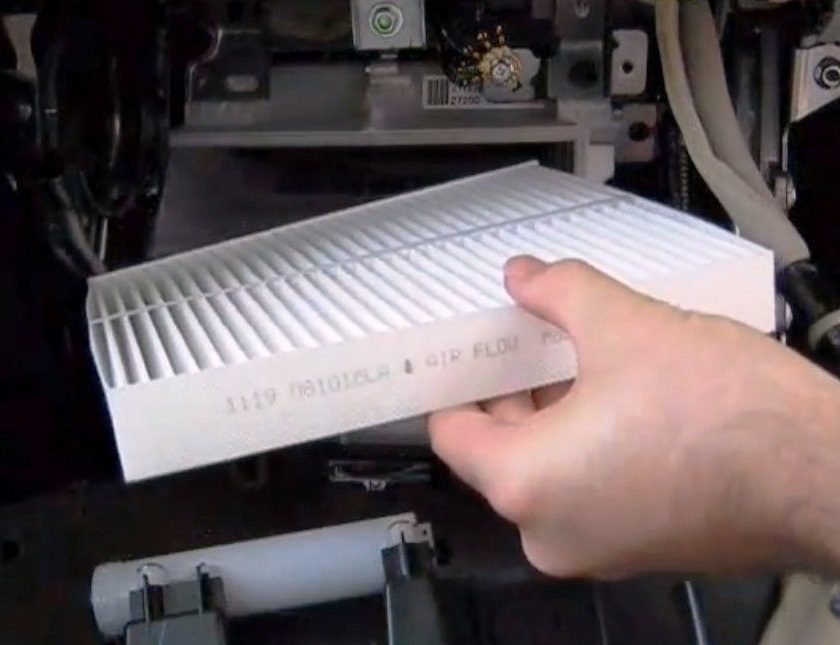
Cabin Filter
The most high-quality and expensive filters are equipped with an additional section filled with activated carbon, due to which they purify the incoming air even from an unpleasant odor.
Radiator
The heat exchanger is the main element of the heater, because it is he who transfers thermal energy from the engine to the air flow passing through it. It consists of several tubes passing through a lattice of metal with high thermal conductivity, usually aluminum or copper. The grid, consisting of individual rib plates, is located so as to provide minimal resistance to the air flow passing through them, but at the same time heat it as much as possible, therefore, the larger the heat exchanger, the more air it can heat per unit time to a given temperature. This part is produced in two main versions:
- a serpentine-curved pipe passing through the ribs - this design is as cheap as possible to manufacture and very maintainable, but its efficiency is low;
- two tanks (collectors) connected by thin tubes passing through the grate, such a design is noticeably more expensive to manufacture and more difficult to repair, but its efficiency is much higher
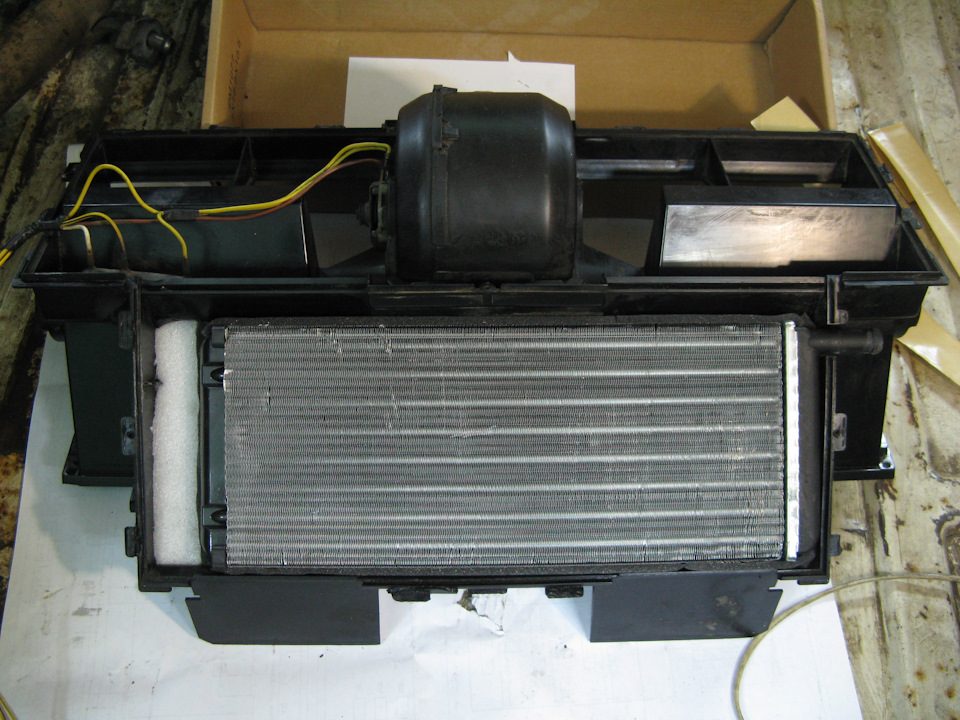
machine heater radiator
Inexpensive models are made of steel and aluminum, better ones are made of copper.
Case with channels
2 channels pass from the fan through the housing, one contains a radiator, the second bypasses the heat exchanger. This configuration allows you to adjust the temperature of the air entering the cabin from the street to the hottest. A damper located at the junction of the channels directs the air flow. When it is in the middle, the air flow enters both channels at approximately the same speed, a shift in either direction leads to the closure of the corresponding channel and the full opening of the other.
Dampers
The car heater has 3 dampers:
- the first one opens and closes the air ducts through which the air flow enters the radiator, it depends on it where the heater will suck in air from, from the street or from the passenger compartment;
- the second controls the air supply to the radiator, which means it regulates its outlet temperature;
- the third distributes the air flow to various deflectors, allowing you to heat both the entire interior and only its individual parts.
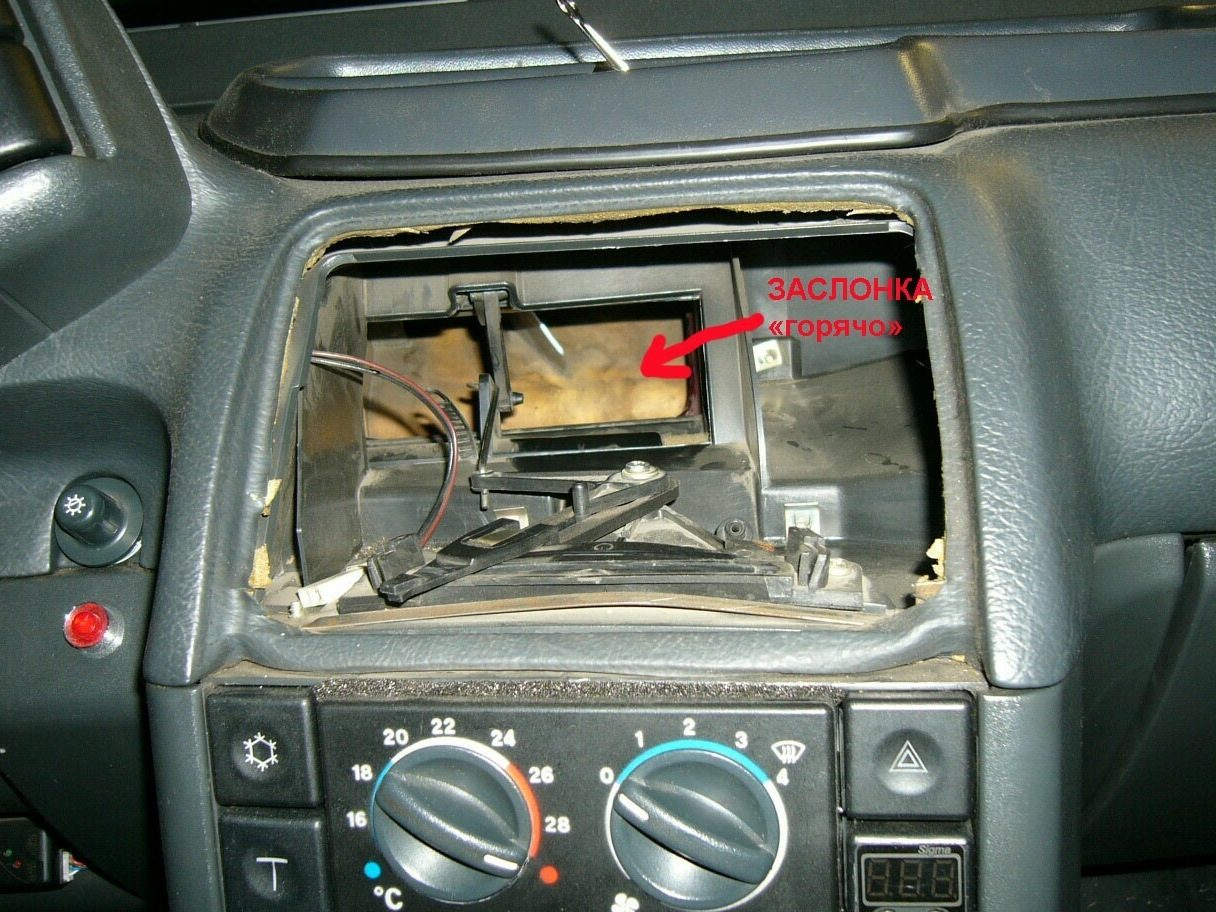
Auto stove damper
In budget cars, the levers and control knobs for these dampers are displayed on the front panel console; on more expensive cars, their operation is controlled by the air conditioner microcontroller.
Air ducts
Depending on the model and configuration of the machine, air ducts are laid both under the front panel and under the floor, and their outlets are located in various places in the cabin. The most popular air outlets are the spaces under the front and rear seats, because this arrangement is ideal for heating not only the upper but also the lower part of the cabin, and therefore the legs of the driver and passengers.
Deflectors
These elements perform 2 important tasks:
- cut the air flow into several smaller flows to reduce the speed of movement while maintaining the total volume of supply;
- protect air ducts from dirt getting into them.

Deflector stoves auto
For example, the deflectors on the "torpedo", that is, the front panel, can be rotated, thus changing the direction of movement of the air coming from them. This function is especially useful if the face is frozen and turning the deflector directs hot air onto it.
Controls
In any car, the stove controls are placed on the front panel or its console, but the way they act on the dampers is different. In the most inexpensive models without air conditioning or a climate control system, the dampers are controlled by rods attached to levers brought out to the outside. In more expensive and prestigious models, as well as top trim levels, everything is controlled by electronics, which receives signals from the buttons and potentiometers displayed on the front panel, as well as from the on-board computer or the climate control unit.
Conclusion
The interior heater is not a separate device, but a complex system connected to the car engine and on-board electrical wiring, and the heat source for it is the fuel burning in the cylinders. Therefore, the answer to the question - what makes the stove in the car work, is obvious, because it is the internal combustion engine that is the real "heater" for the driver and passengers, and the rest of the elements only transfer heat to them, heating the incoming air and distributing it throughout the cabin. Regardless of what kind of car you have - Tavria, UAZ or a modern foreign car, interior heating always works according to this principle.